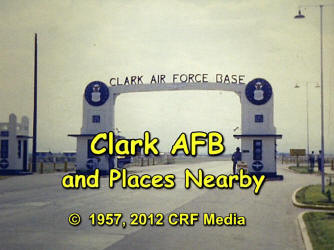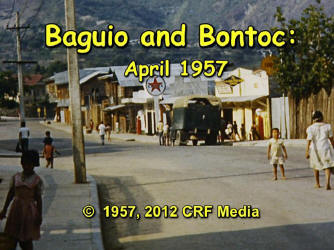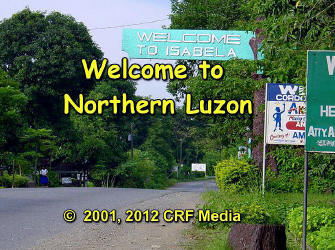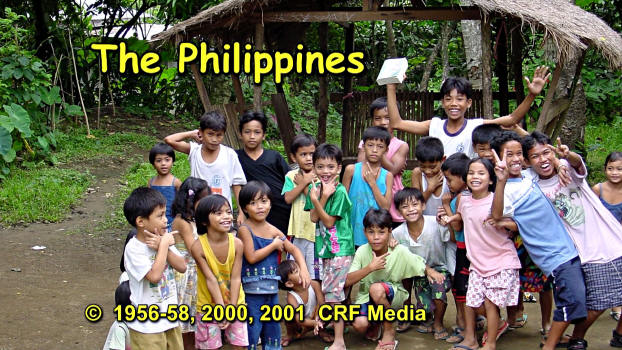|
03 The Philippines 1957-1958 and 2000-2001 17 Chapters (130:53) Script: PI 1956-'58, 2000-'01.pdf 03/25/2023 |
|
|
The first set of videos was filmed with a 16mm movie camera. Recently the film was digitally mastered and then edited to produce high-definition quality videos. In the years 2000 and 2001, we traveled to the Islands helping several evangelical missionaries with their media development. Our prayer is that through these videos you will better understand the people and want to become involved in reaching them for Christ. |
|

01 Mt. Arayat; Harvesting Sugar Cane (2:42) |

02 Clark AFB and Places Nearby (3:57)
|

03 Baguio and Bontoc (10:56) Baguio is about 4
hours bus ride north of Clark. The cool mountain air at 5,000 feet
elevation makes this a favorite vacation spot. |
 04 Manila, Philippines (4:52) Manila is the largest city in the Philippines and the capital of the country. Jeepneys and busses are the prime mode of transportation but the streets downtown are crowded with modern cars, jeepneys, busses and people as well as horse drawn calisas. Manila Bay is a well-protected harbor and the port of call for many ships. In the Bay, relics from the War remain. |

05 Singapore, Japan, Hong Kong (6:02) |
 06 Ambuklao Power Station (4:16) A visit to the Ambuklao Power Station located northeast of Baguio was the last major trip Carl made while in the Philippines. This time he went by himself and the mountain scenery was similar to that on the road to Bontoc. The power plant was an opportunity to see a more modern part of the country. |
 07 Cahigam Baptist Church (6:34) To reach this small community church, we head Southeast of Lipa City into the rural area via a very rough dirt road. We pass through rice and corn fields and finally arrive at a collection of about four to five homes. In the back yard of a home is a small structure with a tin roof, no walls and a dirt floor … the Cahigam Baptist Church. |

08 Back at Clark AFB (4:34)
After Carl's stay at Clark in 1956-58, he has always wanted to return.
In
2000, our friends Darryl and Shirley took us there.
The new main
gate welcomes us to a place much different than before. |

09 It's Sunday in Metro Manila (10:46)
On this Sunday morning, after a late season typhoon, we are heading for a
small church -- "One Faith".
After the
service, we will visit a few places in Manila. |

10 Baguio: 43 Years Later (13:52) Over the years Carl has talked about the Kennon
Road as it winds its way up to Baguio. Soon Arline will be able to see it for
herself. It is a long ride, normally about seven hours from the Pasig
Bus Terminal near Manila. |
 11 Welcome to Northern Luzon (12:07) The rich farmland of the Cagayan Valley is well known for its huge crops of rice and other farm products. But, here too, there places of spectacular scenery and people whose lives are much different from ours. Our destination is the city of Cauayan in Isabela Province; six hours and 200 miles from Manila. The northern part of Island of Luzon is a place of contrasts, of challenges to the mind, body and spirit. |

12 Roxas Baptist Church (7:55)
Join
us as we worship with fellow believers at this church in the city of Roxas. Leading the congregation in worship each Sunday is Lelaine Morales,
the pastor's wife. Most of the music is in English. Pastor Mario Morales
preaches in Tagalog, the national language. |
 13 Schools in the Barrios of Cauayan (7:41) The opening activities at the Ramon National High School began at 7:30 in the morning. Most of the students either walked, rode a jeepney or motorized tricycle. Transportation and the required school uniforms is a significant expense for the families of these teenagers. |
 14 Banaue Rice Terraces (7:54) 2,000 years ago, the Ifugao people began building terraces to grow rice, -- the staple food for much of the Philippines. These terraces were built by hand. The center of the rice terraces is here in Banaue on mountain ridges and steep slopes. The 80 mile drive from Cauayan takes us across the Magat River at Bagabag then up the mountain highway to Banaue. This final 30 miles is a narrow crooked road. |
 15 Working in the Barrios (12:31) Life in the barrios of Cauayan Valley moves along at a seemingly slow pace; much different than in the cities. Plodding along, the caribou pulls its load of green grass toward a place of rest. Field hands follow as they head for some shade to escape the hot mid-day sun. It seems to be an endless ritual.
|
 16 Sharing God's Love Cauayan (10:08) The Scripture is Read A Prayer is Made The 10 Commandments are Displayed A Song is Sung
Pictures of People and Places in Cauayan Valley while song "When I look Into His Eyes" is sung. |
|
Statement About Video Use U.S. copyright laws protect all media material produced by CRF Media. Posting the videos on alternate web sites is NOT ALLOWED. Fragmentation of the material is STRICTLY FORBIDDEN. THEY ARE NOT TO BE USED IN ANY WAY FOR COMMERCIAL APPLICATIONS. |
|

